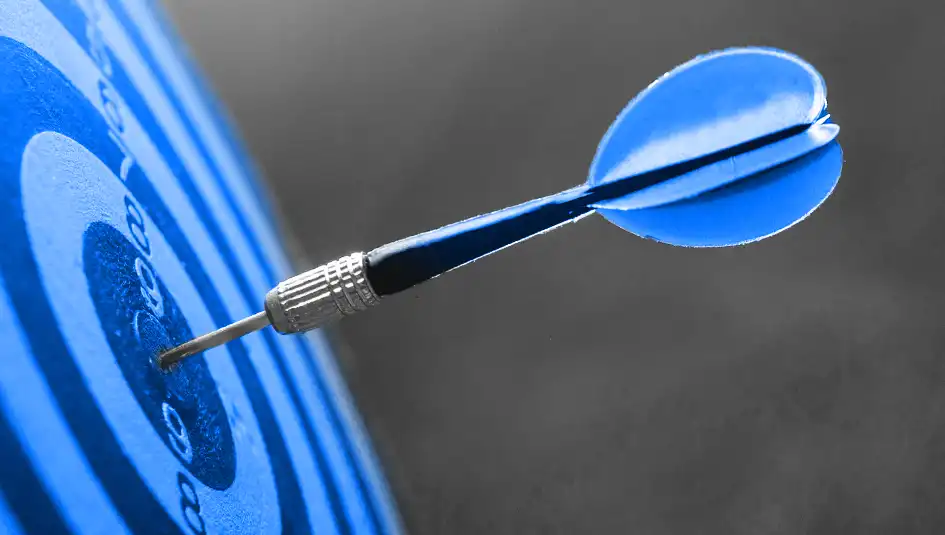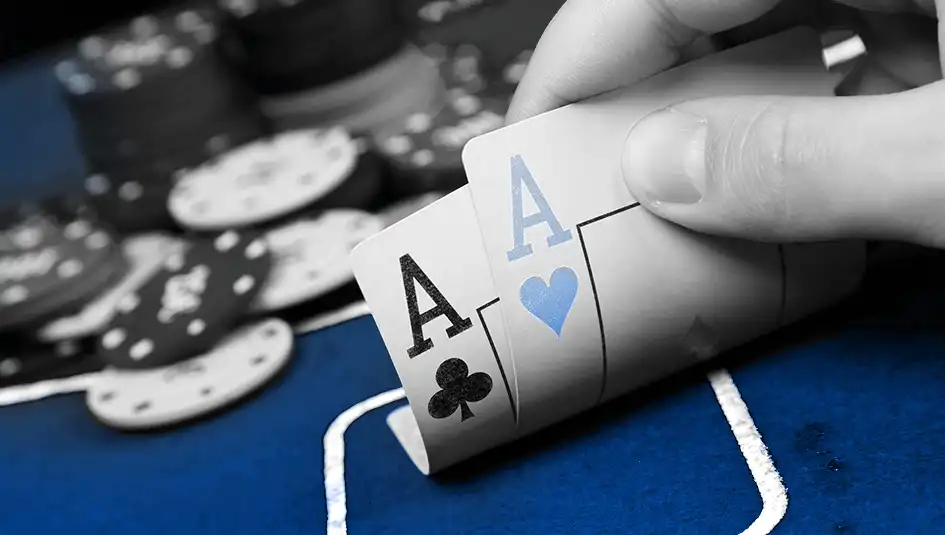Darts Basics
Darts is not a complicated sport and it doesn’t take long to understand how it works. Players take it in turns to throw three darts each at the board. The board is split into segments with scores attached, ranging from 1 up to 60. The board looks like a round cake that has been split into slices and each slice is subdivided into four. There are two thin segments and two fat; the fat segments award the score associated with that slice, the outer thin one awards double the points and the inner thin one awards triple the points. At the centre of the board is the red bullseye, this awards 50 points and the green ring around it awards 25.
Each player starts with 501 points and points are deducted from this total by throwing darts at the board. The aim is to reach 0 points with as few throws as possible. To check out and win the game, the player needs to hit a double or the bullseye. A perfect round, or leg, will use just nine darts.
Darts is usually played over a number of sets or games, depending on the tournament. The games are called legs and a set is usually the best of five legs, so the first to three legs wins. In the later stages of a tournament, there will usually be more legs or sets.
Dart Terminology
As with any sport, there is various terminology associated with darts and it is important to understand it.
- 501 – The number of points that a player starts with and needs to score down from in order to win. As mentioned, to win, you must check out on a double or in the bullseye.
- Double – The outermost section of each segment on the dartboard. It awards double points when hit.
- Check Out – The score a player must hit in order to win a game. For example, 60. A Player could hit a single 20 and then a double 20 to win.
- Treble/Triple – The inner section of each segment on a dartboard. It awards triple the points when hit.
- Bullseye or Bull – The small red circle at the centre of the dartboard. It awards 50 points when hit. Surrounding it is a small green circle that awards 25 points when hit.
- Chalker – The person who scores and chalks the game and each throw of a dart.
- Oche – The stand where players throw from.
- Ton – A score of 100.
- Ton 80 – A score of 180, which is the most that can be achieved with three darts (three triple 20s).
- Tops – A term for double 20.
- Nine darter – To check out from 501 using nine darts exactly, the fewest number possible.
Darts Betting Markets
There are many different betting markets available when betting on darts and it is important to make sure that you understand all of them when placing a bet in order to make the most of them. Here is an explanation of the most important ones.
Outright Winner
This is the most basic of bets. It is simply on which of the players will win the tournament or match. If you think that there is a clear favourite, then it is the perfect market to use, and if you do so early in a tournament then you may find some very generous odds.
Match Winner
In the vast majority of darts matches, this is a two way market and you simply pick one of the players to win the match. The only exception to this is the early stages of the Premier League of Darts tournament where there is also the option to draw.
Correct Score
Regardless of whether it is the best of 5 legs or sets, you can use this market to predict the exact score at the end of a match (e.g. a player to win 4 sets to three). Usually, these markets have very generous odds, as it is hard to predict an exact score.
Over/Under Full Time
This is a bet on the total number of legs or sets in a match. Usually it is presented as something like Over 5.5 or Under 5.5, meaning that if you bet over there needs to be at least 6 in order to win the bet. Very often, these markets also come with handicap bets. For instance, if the match is the best of five sets, you may be able to bet on -2.5, meaning that the player needs to win 3 – 0. This is a way of finding better odds on the favourite, rather than making use of the shorter odds for match winner.
Most 180s
This is a simple bet on which player will score the most 180s in a game. Very often, you will also be able to bet on the most 180s in a leg or set during the game.
Highest Match Check Out
This is a bet on which of the players will achieve the highest check out (winning the game from the highest score).
170 Finish in Match
The highest possible check out is 170, a combination of two treble 20s and a bullseye. This is simply a bet on whether or not there will be one in the match (it doesn’t matter which player achieves it).
First 180 in Match
A simple bet on which of the two players will be the first to score 180.
Nine Dart Finish in Match
Nine is the fewest number of darts needed to reach the score of 501. This is simply a bet on whether or not a player will manage it during a match. The odds for this market are usually very generous on Yes, as it is a rare and difficult achievement.
Winner Highest Checkout
This is a bet on which player will achieve the highest checkout in a match. It simply requires you to bet on one of the two players.
There are a number of other darts betting markets offered on some games, such as First Dart in Match, which is a bet on where the first dart will land. Using the above bets as a guide, the remaining markets, when offered, should be self-explanatory. The same is true of the Live Betting markets, such as Winner Next Leg (a bet on the winner of the next leg). When betting on a dart match, be sure to look at all the markets carefully and think how you can use them together to cover as many outcomes as possible and give yourself the best chance of placing winning bets.
Things to Be Aware of When Betting on Darts
As with any sport, the key to placing successful bets is to do carefully research beforehand. You need to understand not only the players’ strengths and weaknesses, but also how they apply in different tournament formats.
In the vast majority of darts tournaments, players will compete over a series of legs. In the later stages of a tournament, there may be numerous legs, such as the best of 19 (meaning that the first player to 10 wins). Early in the tournament, there may be as few as seven legs. This means that the later stages of a tournament will favour the better players as it gives them time to settle into the game and find their rhythm. Even if they fall behind to begin with, they will have plenty of time to make a comeback.
However, when it comes to the shorter formats, there is more space for an upset. If the underdog manages to get ahead quickly, this could throw the favourite and they may not have time to recover. Therefore, when betting on shorter format matches, it is important to consider the underdog carefully and how quickly the favourite tends to settle into matches.
Another thing to be aware of is the danger of just focusing on the big events. When a major event comes along, such as the PDC World Championships, there will be a flurry of betting activity. However, many minor competitions take place throughout the darts season, include tours of Europe and Australasia, with events in countries such as the Czech Republic, Denmark, New Zealand and Australia.
These events give you a great opportunity to familiarise yourself with the players and see how they perform in different circumstances. Furthermore, they also offer more opportunities to place bets, and as some of the bigger name players choose to miss these smaller events, you will often find great value bets on some of the other names. In other words, be sure to keep a careful eye on the entire darting calendar as this way not only will you learn more about the players but will have the best chance of finding the most generous odds.

 A Beginner’s Guide to Cricket Betting
A Beginner’s Guide to Cricket Betting A Beginner’s Double Double Bonus Video Poker Strategy
A Beginner’s Double Double Bonus Video Poker Strategy